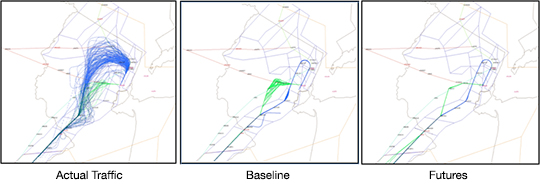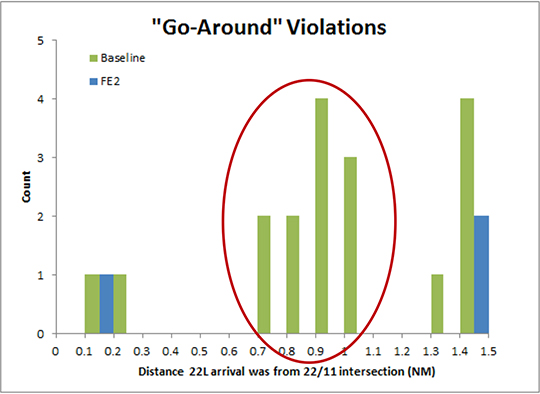|
|
 |

|
 |
 |
The New York area airspace is notoriously complex and demanding, and is responsible for a large portion of the delays and congestion in the United States. A new research effort was initiated to examine the chronic problems associated with New York, and to develop integrated NextGen concepts that leveraged existing NASA and other NextGen technologies to reduce delays, increase throughput, and/or improve trajectory efficiencies in this region.
A new research effort called New York Operational Improvements was initiated to address this issue. The research approach has been to develop and refine integrated NextGen trajectory based operations (TBO) that leverage existing NASA and other NextGen technologies to enable precise scheduling and delivery of aircraft along coordinated trajectories. These integrated tools, operations, and procedures focused on specific New York problems that can result in NAS-wide delays and congestion. The NY area presents a rich set of challenges to test the efficacy of new capabilities including excess demand, chronic delays, severe weather, and airspace complexity. Its inefficiencies are of national as well as regional importance, as it accounts for approximately 50% of the NAS-wide delays. Thus NextGen solutions that could alleviate problems in this airspace would provide significant value to stakeholders nation-wide.
The first objective of the research was to learn about the different NY bottlenecks that cause delays and limit capacity. Once the bottlenecks are identified, they can then be tackled, one at a time, by developing an integrated operational concept that addresses each specific problem before evaluating the concept in a human-in-the-loop (HITL) simulation. NY area subject-matter-experts (SMEs) were consulted to identify capacity bottlenecks in the clear weather days to determine the test area and problems that could be addressed. Through this process, a number of potential improvements were identified for the arrival and/or departure problems at the NY airports, as well as the Terminal Radar Approach Control (TRACON) and En Route airspace that feed traffic into these airports.
The problem selected for our initial investigation was that of improving the throughput and efficiency of arrivals inbound for Newark Liberty International (EWR) airport during clear weather, with the test airspace encompassing flows coming from the south through Washington Center (ZDC). An initial HITL simulation in the AOL addressing the New York airspace explored the feasibility of a NextGen TBO solution to address airspace and airport capacity limitations in and around the New York Metroplex. A concept, tools, and operational procedures for improving flight efficiency and runway throughput for EWR arrivals were developed to create a precise, dependent-runway schedule between two intersecting runways. A week-long study, conducted in August 2013, explored the feasibility of a new Optimal Profile Descent (OPD) arrival into the airspace as well as a novel application of the TMA-TM arrival scheduling tool to coordinate high volume arrival traffic to intersecting runways. In the simulation, four en route sector controllers and four TRACON controllers managed traffic inbound to EWR's primary runway, EWR22L, and its intersecting overflow runway, EWR11. TMA-TM was used to generate independent arrival schedules for each runway, while a traffic management coordinator participant adjusted the arrival schedule so that each EWR11 followed a EWR22L aircraft. CMS tools were also provided to assist the TRACON controllers in managing the arrivals descending on OPDs.
The study compared the throughput and safety of an experimental condition labelled Futures using the TMA-TM tools with dependent-runway scheduling, with a Baseline condition that did not. Figure 1 shows the lateral trajectories of the arrivals on OPDs in the Baseline and Futures conditions (5 hours of Baseline and Futures condition runs, with 190 and 198 simulation trajectories, respectively), compared to 24 continuous hours of actual operational data for arrivals from ZDC for EWR22L or EWR11 on a clear weather day (June 27, 2011, 316 aircraft trajectories). The figure illustrates that the OPD RNAV trajectories used in the study resulted in fewer lateral path deviations than the trajectories from the operational data.

Figure 1: Trajectories from 2011/06/27 operational data (left), Baseline condition (middle) and Futures condition (right).
The results suggested that the efficient RNAV descent procedures were compatible with converging-runway operations using the modified TMA-TM and the controller tools. Further, the combined use of the tools with the new OPDs produced a peak arrival rate of 67 aircraft per hour using instrument flight rules (IFR), exceeding the current maximum arrival rate at EWR of 52 per hour under visual flight rules (VFR). In the Futures condition, the controllers were able to deliver arrival aircraft precisely on OPDs at a high throughput rate for both EWR22L and EWR11 runways with less vectoring, fewer lateral path deviations, and a lower workload. More importantly, a coordinated schedule across the two intersecting runways at a high-throughput rate was successfully managed with minimal coordination using the TMA-TM tools. A coordinated schedule allowed the controllers to deliver their aircraft to the slot markers with the assurance that they would result in conflict-free delivery at the converging runways. The schedule and the slot markers were created taking winds in the account, and therefore the controllers could deliver the aircraft safely even during high wind conditions. In the Baseline condition, the controller needed to make last minute path adjustments on the EWR11 arrivals in order to pair them with the leading EWR22L arrivals, resulting in more lateral path deviations.
In terms of safety, the "go-around" violation data suggested that only the Futures condition could safely increase throughput. The go-around violations were logged whenever the arrivals on EWR11 and EWR22L were spaced too closely to each other during landing. A go-around violation was defined as occurring if the aircraft landing on EWR11 was at its threshold and the aircraft landing on EWR22L had not yet crossed the runway intersection and was less than 1.5 miles out. Figure 21 shows all of the go-around violations that occurred in the study. There were three go-around violation cases observed in the Futures condition, but they were borderline cases that, as identified during a follow-up discussion with a subject-matter expert from EWR tower, in today’s operations would not be considered a violation. Therefore, the go-around violations with safety implications occurred only in the Baseline condition (circled in Figure 2).

Figure 2: Go-Around Violations.
A follow-up benefit analysis was performed to evaluate the annualized benefit of the increased traffic once the realistic wind and traffic demand were taken into account. The analysis examined the meteorological conditions suitable for using the 11-22L landing runway configuration, and estimated the actual resulting potential for increasing arrival throughput. Aviation System Performance Metrics (ASPM) data were used to determine the traffic demand, runway configurations, meteorological conditions, and wind magnitudes/directions during 2007, 2009 and 2012. The annualized benefit analyses consisted of two parts: (1) identifying the availability of using runway 11 in addition to runway 22L under favorable wind and meteorological conditions beyond the current level of its usage, and (2) applying the increased throughput identified by the simulation study to the 11-22L arrival configuration that can be used across an entire year. Using fairly conservative assumptions about the meteorological conditions, runway usage, and peak demand characteristics, the analysis showed that the 11-22L runway configuration could have been used more than twice as often during high-demand periods (i.e., when arrival demand exceeded throughput), which in turn could have either reduced delays to the impacted aircraft by approximately 15 minutes per aircraft, or increased the overall throughput by approximately 8% - 11% per year. This new operation has the potential to deliver even greater benefits if it were extended to include other runway configurations and demand conditions. The results suggest that a large throughput/delay benefit can be gained from a modest extension of the TMA-TM and make a significant impact in the New York area.
In the years 2014 and beyond, we plan to explore other New York problems and potential solutions that can reduce delays and congestions using integrated NextGen tools, operations, and procedures. In 2014, we are examining ways to reduce departure delays at LaGuardia airport by intelligently scheduling and managing arrival spacing. The study will be conducted in August, 2014.
Points of Contact: Nancy Smith, M.S., Human Systems Integration Division, NASA Ames Research Center; Paul Lee, Ph.D., Human Systems Integration Division, NASA Ames Research Center; |
|
|